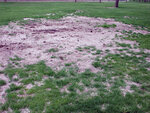

Summer has arrived in South Minneapolis and you may have started to notice dead patches in your lawn. There are many potential culprits for lawn damage and, unfortunately, they can be difficult to predict or treat. Before you call a lawn service (or blame your dog), read on to learn about some potential culprits and options for prevention or mitigation.
White grubs are probably the most common cause of irregular patches of dead grass. White grubs are the larvae of several species of scarab beetles (including June Beetles and Japanese Beetles). Adult beetles lay their eggs in your lawn in June and July, and the larvae hatch and begin to eat the roots of grass plants a few weeks later, so you may begin to see grub damage in July and August. Because the grubs eat grass roots, in areas of severe damage, you may be able to roll back the sod like a carpet. It is very difficult to predict where or whether grub damage may occur from year to year. Some people choose to apply a preventative insecticide treatment every year to head off any potential lawn damage. However, you can also wait and see if grubs are present in your lawn and apply a curative treatment later in the summer to reduce damage if they do occur. Keep in mind that most insecticides that are effective on white grubs are also toxic to bees and other pollinators, so make sure to follow application directions very carefully if you choose to treat your lawn.
Another common lawn issue is damage related to ice cover. This occurs when water from the spring snow melt cannot freely drain from an area, and there are frequent freezing and thawing cycles during the snow melting process. If you notice light tan-colored dead grass in low areas of the lawn or along the edges of curbs, driveways, or sidewalks, with a distinct boundary between dead and healthy grass, this may be damage related to ice cover. To mitigate the issue next year, consider grading or filling affected areas to reduce drainage issues next spring.
Heat and drought can also stress your lawn. This generally occurs when temperatures are above 85 degrees and there is little moisture for two to three weeks. You may notice a general browning or thinning of the entire lawn, or patches of damage. To mitigate this type of stress, consider watering your lawn periodically during hot, dry periods. To reduce water usage, keep in mind that most types of turf grass only need a quarter inch to an inch of water per week. It’s best to water between 4 a.m. and 8 a.m. to reduce evaporation.
“Patch disease” is a general name for several types of common lawn fungus that can also cause brown lawn spots. Damage is often found in round, ring-shaped, or arc-shaped areas and commonly appears when a period of hot, dry weather follows a period of cool, wet weather. Patch diseases typically arise when the lawn is already stressed for various reasons, including poor soil conditions or excessive thatching. There are unfortunately no quick fixes for patch diseases, but improving the underlying lawn conditions can help keep lawn funguses under control. Consider having your soil tested by the University of Minnesota Extension to determine whether you should apply fertilizer or organic material. Dethatching or aerating your lawn can also improve air circulation, making conditions unfavorable for funguses to develop.
There are many more diseases and details than I can fit in this space, so I’ll also recommend the “What’s Wrong With My Plant?” feature on the University of Minnesota Extension Yard and Garden website. This page can help you identify specific lawn and garden issues by answering a few simple questions. Whether your lawn is afflicted with a fungus, pest, or just plain old dog spots, there is plenty of research-based information and expert advice available to help you figure out what to do. Happy gardening!
For more information, check out the University of Minnesota Extension Yard and Garden website. Extension resources are written by experts, and contain the latest and most reliable research-based information. Happy gardening!
Comments
No comments on this item Please log in to comment by clicking here